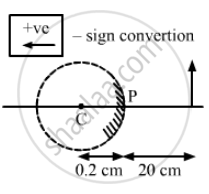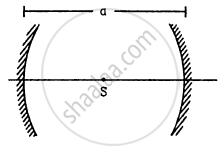Advertisements
Advertisements
Question
A candle flame 1.6 cm high is imaged in a ball bearing of diameter 0.4 cm. If the ball bearing is 20 cm away from the flame, find the location and the height of the image.
Solution
Given,
Height (h1) of the candle flame taken as object AB = 1.6 cm
Diameter of the ball bearing (d) = 0.4 cm
So, radius = 0.2 cm
Distance of object, u = 20 cm
Using mirror formula,
\[\frac{1}{v} + \frac{1}{u} = \frac{2}{R}\]
Putting the values according to sign conventions, we get,
\[\frac{1}{( - 20)} + \frac{1}{v} = \frac{2}{0 . 2}\]
\[ \Rightarrow \frac{1}{v} = \frac{1}{20} + 10\]
\[ \Rightarrow v = 0 . 1 cm or 1 . 0 \text{ mm inside the ball bearing . }\]
\[Magnification = m\]
\[ = \frac{A'B'}{AB} = - \frac{v}{u} = m\]
\[ = \frac{A'B'}{200} = \frac{1}{200}\]
\[\Rightarrow A'B'=\frac{AB}{200}=+\frac{1 . 6}{200} = + 0 . 08 \text{ cm } (+0008\text{ cm })\]
Hence, the distance of the image is 1 cm.
Height of the image is 0.008 cm.
APPEARS IN
RELATED QUESTIONS
Fill in the blank:
Very fine particles mainly scatter ………… colored light.
Write two points of difference between the phenomena of interference and diffraction.
Why does the Sun look reddish at sunset or sunrise ?
What is linearly polarized light?
A convex lens is made of a material having refractive index
\[1 \cdot 2\] Both the surfaces of the lens are convex. If it is dipped into water (μ = 1.33), it will behave like
A point object O is placed on the principal axis of a convex lens of focal length f = 20 cm at a distance of 40 cm to the left of it. The diameter of the lens is 10 cm. An eye is placed 60 cm to right of the lens and a distance h below the principal axis. The maximum value of h to see the image is
A concave mirror having a radius of curvature 40 cm is placed in front of an illuminated point source at a distance of 30 cm from it. Find the location of the image.
A concave mirror forms an image of 20 cm high object on a screen placed 5.0 m away from the mirror. The height of the image is 50 cm. Find the focal length of the mirror and the distance between the mirror and the object.
A 3 cm tall object is placed at a distance of 7.5 cm from a convex mirror of focal length 6 cm. Find the location, size and nature of the image.
A point source S is placed midway between two converging mirrors having equal focal length f as shown in figure. Find the values of d for which only one image is formed.
Light falls from glass (μ = 1.5) to air. Find the angle of incidence for which the angle of deviation is 90°.
A paperweight in the form of a hemisphere of radius 3.0 cm is used to hold down a printed page. An observer looks at the page vertically through the paperweight. At what height above the page will the printed letters near the centre appear to the observer?
Answer the following question in detail.
State the conditions under which a rainbow can be seen.
Answer the following question in detail.
Explain the formation of a secondary rainbow. For which angular range with the horizontal is it visible?
Pick the wrong answer in the context with rainbow.
State any one difference between a primary rainbow and a secondary rainbow.
Explain the formation of primary and secondary rainbow.
A short pulse of white light is incident from air to a glass slab at normal incidence. After travelling through the slab, the first colour to emerge is ______.
A passenger in an aeroplane shall ______.
